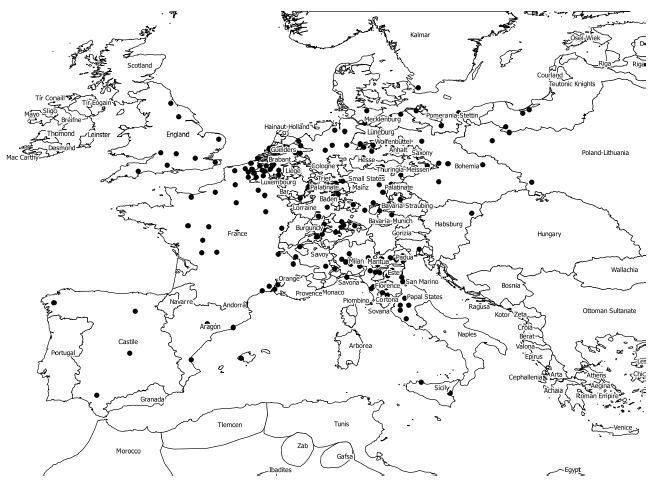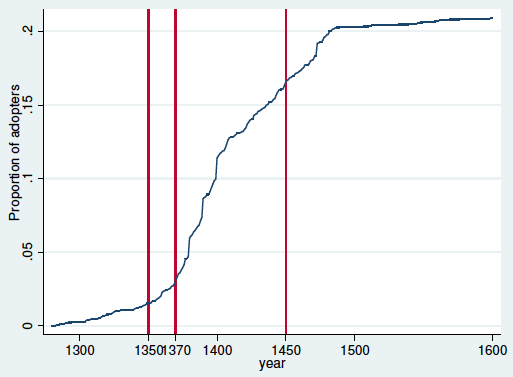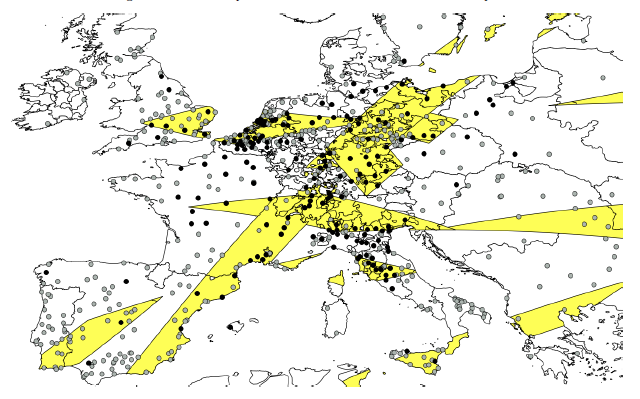“Remember that time is money.” Already in 1748, Benjamin Franklin underlined in a short contribution to a business manual that the temporal aspect is a pivotal variable for the economy. This statement is even more relevant to today's business activities. The precise measurement of time is fundamental to schedule business meetings exactly on the minute and the hour, to have opening hours for retail business, or to synchronise exchange activities on financial markets. The measurement of time allows monitoring and coordinating production processes and it is crucial to improving labour efficiency (Landes 1983, Mokyr 1992). Indeed, improving coordination and reducing transaction costs are so basic and self-evident that the underlying need for a common precise time measurement gets almost forgotten.
A brief history of time
However, looking at the evolution of mankind, the concept of the precise measurement of time is surprisingly rather recent. Until the late Middle Ages, people had to rely on sun or water clocks, which did not play any role in basic life and business activities. Market openings and activities started with the sun rise and typically ended at noon when the sun was at its zenith, while a labour day was as long as the sun was up and pay by the hour did not exist.
Different attitudes on punctuality had started by the late Middle Ages, when the first public mechanical clocks were introduced and spread across European cities. These clocks were typically built on church towers or on the communal tower of the town, and were mechanical devices that produced a weight-driven acoustic signal every hour. These early mechanical clocks did not have a dial, but only worked with a bell. The day was typically divided into two units of twelve, and the bells rang accordingly as many times. In this way, the clocks were publicly accessible and easy for everyone to understand, and the knowledge for enjoying this technology was very simple – a person only had to listen to the chime and have the ability to count.
New technologies and growth: Mixed evidence
The study of mechanical clocks can shed some light on growth dynamics in the Western World that can be achieved by the accumulation of knowledge and the improvement or introduction of new technologies. Unfortunately, the answer is not that clear. On the one hand, studies carried out before the 1990s (e.g. Ricardo 1821, Leontief 1983, Samuelson 1988) claimed a negative relationship between machines and wages (and thus population and income growth). On the other hand, in the last 20 years – which coincide with the introduction of new innovations in information technology – new research has found a more differentiated picture of this relationship. In a 1987 article published in the New York Times, Robert Solow underlined a productivity paradox (now known as the Solow Paradox) that highlights that the 1970s US productivity slowdown concurs with the adoption of computers ("You can see the computer age everywhere but in the productivity statistics"). However, other scholars have found the advantage and the positive effects of the spread of computers on society. For instance Bresnahan et al. (2002) underline the positive role of hi-tech capital and the complementarity with skills and innovations at the firm level. Finally, the debate has been recently kindled by Robert Gordon (2016) with his historical and economic analysis of inventions and US economic growth.
In a recent paper, we study the impact of the spread of these first public mechanical clocks on the economic growth and development of Western European cities and regions in the long run (Boerner and Severgnini 2015). This fundamental question is not new – it has been discussed by social scientists such as Marx, Sombart, and Weber – but it has never been analysed quantitatively and tested empirically. The introduction of clocks and a precise way of measuring time is also linked to the impact of a new general purpose technology for a society. Our study is in line with the suggestion of Paul David (1990), which explains the Solow Paradox from an historical perspective.
The impact of public mechanical clocks on growth
Our research shows that public mechanical clocks had a big impact on growth in the places that were early adopters of the new technology. We significant growth effects based on the diffusion rate of mechanical clocks, which supports the view that general purpose technologies can have a strong impact on economic growth. However, it takes time for such fundamental innovations to have an effect because the technology must be culturally and socially accepted and applied in related economic activities.
Starting in the late 13th century, clocks started spreading simultaneously across Italy, Germany, and England, and then spread until 1450 in most other Western and Central European Countries, including Belgium, the Netherlands, France, Spain, Poland, the current Czech Republic, and Scandinavia (Figure 1) The spread followed the s-shaped distribution curve that is typical for new technologies. The distribution weighted by the total population size started slowly, then rose exponentially, and finally slowed down again, reaching a saturation point in 1450 with a relative decreasing adoption rate (Figure 2)
Figure 1 The diffusion of the mechanical clock, 1450
Figure 2 The diffusion curve of the mechanical clock
Building a clock in a town was motivated by prestige and not by economic needs – towns did not forecast any of the benefits clocks would bring in the long run, or what can be seen ex post as an economically efficient application. Consequently, the economic use of clocks was a slow process of adoption. Whereas the use of clocks for coordination activities, such as market times or administrative town meetings, can already be observed during the 14th and 15th centuries, the use of clocks to monitor and coordinate labour processes evolved only slowly, in particular during the 16th century. Finally, a cultural adoption reflected in the daily cultural and philosophical thinking of the time can be observed from the middle of the 16th century, for instance with the Protestant movement (in particular with John Calvin's propagation of the concept of “scarce time”). The 17th century also brought forth scientists and philosophers such as Robert Boyle and Thomas Hobbes, who used the clock as a metaphor for the functioning of the world and to explain how institutions such as the state should work.
Looking at this slow process it is not surprising that it took some time before the complementary organisational, procedural, and cultural behavioural innovations transformed into economic growth. Based on empirical growth regressions, we find that compared with other cities, earlier adopters – cities which adopted the clock before 1450 – display significant growth differences in the range of 30 percentage points for the period of 1500-1700. These results indicate that public clocks as a general purpose technology did indeed have localised spillover effects on various economic and economy-supporting activities and led to higher city growth rates. This approach helps explain economic growth from a micro perspective. As an extension and alternative approach, we study countries’ GDP growth rates. This makes it possible to estimate comparative growth effects between countries and create a macroeconomic perspective. Again, we find significant growth effects based on the diffusion rate of mechanical clocks on economic growth.
To control for potential endogeneity problems between the cause (technological change) and consequence (economic growth), we use an instrumental variable approach in our empirical investigation. This means that we consider the main explanatory variable with different instruments that correlate with the implementation of clocks, but not with economic growth. We look in particular at different appearances of solar eclipses and use them as instrumental variables. Historians have convincingly shown that the creation of astrolabes – the predecessors to (and technological basis for) mechanical clocks – was triggered by solar eclipses. We combine these insights with geographical data provided by NASA on solar eclipses from the year 800 until the end of the 13th century. Figure 3 shows the area covered by total and annular solar eclipses and the cities adopting a mechanical clock at the early stage. Using this strategy, the importance of the mechanical clocks is confirmed.
Figure 3 Parts of Europe with more than one total or annular solar eclipse
Note: Cities that adopted a public mechanical clock early in black.
Concluding remarks
To conclude, the good news is that new general purpose technologies can have a fundamental impact on economic growth, and the policy implication is that it is indeed important to implement new technologies and let societies learn to use them and adapt to them. However, it can take generations to reap the full benefits of new high-tech machines; quick gains might not be achievable.
References
Boerner, L. and B. Severgnini (2015), “Time for Growth”, LSE Economic History Working Paper No. 222/2015.
Bresnahan, T. F., E. Brynjolfsson, and L. M. Hitt (2002), “Information Technology, Workplace Organization, and the Demand for Skilled Labour: Firm-Level Evidence”, The Quarterly Journal of Economics 117(1): 339-376.
David, P. A. (1990), “The Dynamo and the Computer: An Historical Perspective on the Modern Productivity Paradox”, American Economic Review 80(2): 355-361.
Gordon, R. J. (2016), The Rise and Fall of American Growth: The U.S. Standard of Living since the Civil War, Princeton University Press.
Landes, D. (1983), Revolution in Time, Harvard University Press.
Leontief, W. (1983), “National Perspective: The Definition of Problems and Opportunities”, in The Long-Term Impact of Technology on Employment and Unemployment, National Academy of Engineering.
Mokyr, J. (1992), The Lever of Riches: Technological Creativity and Economic Progress, Oxford University Press.
Ricardo, D. (1821), On the Principles of Political Economy and Taxation, 3rd edition, John Murray.
Samuelson, P. A. (1988), “Mathematical Vindication of Ricardo on Machinery”, Journal of Political Economy 96(2): 274-82.





